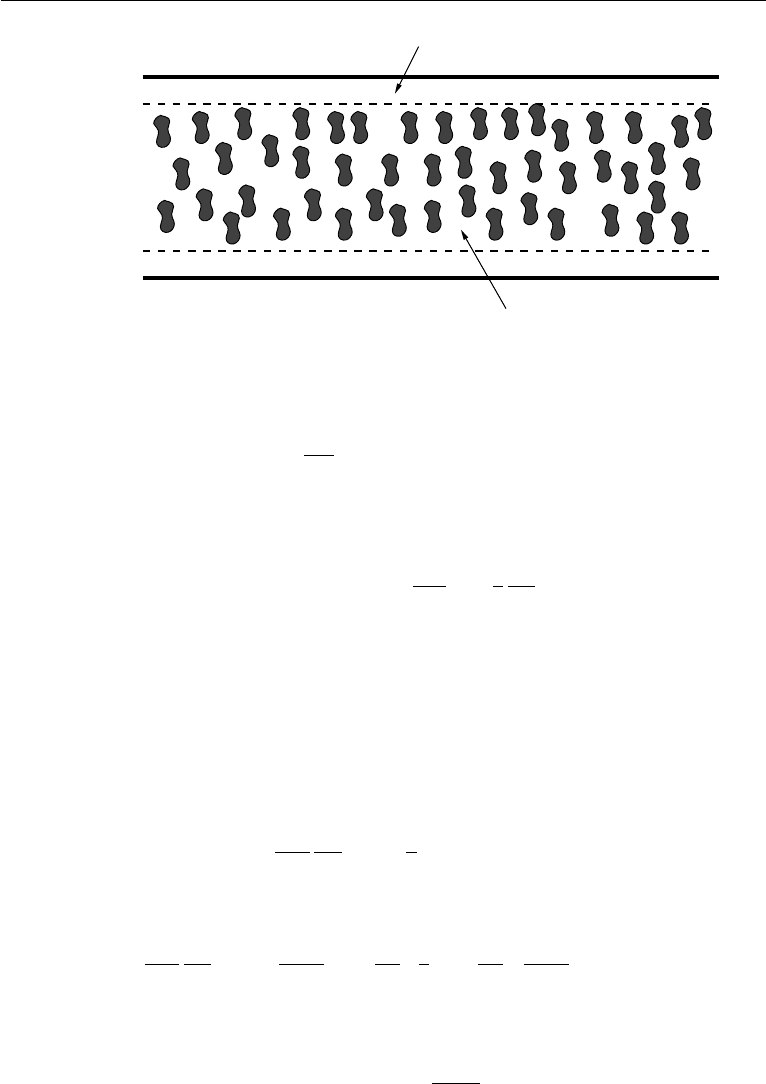Cohen I.M., Kundu P.K. Fluid Mechanics
Подождите немного. Документ загружается.


782 Introduction to Biofluid Mechanics
3. Modelling of Flow in Blood Vessels
There are approximately 100 000 km of blood vessels in the adult human body (Brown
et al. (1999)). In this section, we will examine several models for describing blood
flow in some important vessels.
General Introduction
Blood flow in the circulatory system is in general unsteady. In most regions it is
pulsatile due to the systolic and diastolic pumping. In pulsatile flow, the flow has a
periodic behavior and a net directional motion over the cycle. Pressure and velocity
profiles vary periodically with time, over the duration of a cardiac cycle. A dimension-
less parameter called the Womersley number, α, is used to characterize the pulsatile
nature of blood flow, and it is defined by:
α = a
ω
ν
, (17.12)
where, a is the radius of the tube, ω is the frequency of the pulse wave (heart rate
expressed in radians/sec), and ν is the kinematic viscosity. This definition shows that
Womersley number is a composite parameter of the Reynolds number, Re = u 2a/ν,
and the Strouhal number, St = ω 2a/u . The square of the Womersley number is
called the Stokes number. The Womersley number denotes the ratio of unsteady
inertial forces to viscous forces in the flow. It ranges from as large as about 20 in the
aorta, significantly greater than 1 in all large arteries, to as small as about 10
−3
in the
capillaries. Let us estimate the Womersley number for an illustration. With a normal
heart rate of 72 beats per minute, ω = (2 π 72/60) ≈8 rad/s. Take ρ = 1.05gcm
−3
,
µ = 0.04 g cm
−1
s
−1
and an artery of radius a = 0.5 cm. Then α ≈ 7. Decreasing
α values correspond to increasing role of viscous forces and, for α<1, viscous
effects are dominant. In that highly viscous regime, the flow may be regarded as
quasi-steady. With increasing α, inertial forces become important. In pulsatile flows,
flow separation may occur both by a geometric adverse pressure gradient and/or by
time varying changes in the driving pressure. Geometric adverse pressure gradients
may arise due to varying cross sectional areas through which the flow occurs. On
the other hand, time varying changes in a cardiac cycle result in acceleration and
deceleration during the cycle. An adverse pressure gradient during the deceleration
phase may result in flow separation.
Blood vessel walls are viscoelastic in their behavior. The ability of a blood ves-
sel wall to expand and contract passively with changes in pressure is an important
function of large arteries and veins. This ability of a vessel to distend and increase vol-
ume with increasing transmural pressure difference (inside minus outside pressure)
is quantified as vessel compliance. During systole, pressure from the left ventricle is
transmitted as a wave due to the elasticity of the arteries. Due to the compliant nature
of the arteries and their finite thickness, the pressure travels like a wave at a speed
much faster than the flow velocity. Since blood vessels may have many branches, the
reflection and transmission of waves in such branching vessels significantly compli-
cate the understanding of such flows. In this chapter, a reasonably simplified picture

3. Modelling of Flow in Blood Vessels 783
of these various complex features will be presented. Further reading in advanced
treatments such as the book by Fung (1997) will be necessary to obtain a comprehen-
sive understanding.
First we start with the study of laminar, steady flow of blood in circular tubes,
and in subsequent sections, we shall consider more realistic models.
Hagen-Poiseuille Flow
In the simplest model, blood flow in a vessel is modelled as a laminar, steady, incom-
pressible, fully developed flow of a Newtonian fluid through a straight, rigid, cylin-
drical, horizontal tube of constant circular cross section (see Fig. 17.11). Such a flow
is called the circular Poiseuille or more commonly as the Hagen-Poiseuille flow. This
flow has been treated in Chapter 9, Section 5.
How valid is the Hagen-Poiseuille model?
In the normal body, blood flow in vessels is generally laminar. However, at high
flow rates, particularly in the ascending aorta, the flow may become turbulent at or
near to peak systole. Disturbed flow may occur during the deceleration phase of the
cardiac cycle (Chandran et al. (2007)). Turbulent flow may also occur in large arteries
at branch points. However, under normal conditions, the critical Reynolds number,
Re
c
, for blood flow in long, straight, smooth blood vessels is relatively high, and the
flow remains laminar. Let us consider some estimates. The aorta is about 40 cm long
and the average velocity of flow in it is about 40 cm/s. The lumen diameter at the
root of the aorta is d = 25 mm, and the corresponding Re = ρud/µis 3000. The
maximum Reynolds number may be as high as 9000. The average value for Re in the
vena cava is about 3000. Arteries have varying sizes and the maximum Re is about
1000. For Newtonian fluid flow in a straight cylindrical rigid tube, the critical Re
c
is
about 2300. However, aorta and arteries are distensible tubes, and the Re
c
of 2300
criterion does not apply. In the case of blood flow, laminar flow conditions generally
prevail even at a high Reynolds number of 10,000 (Mazumdar (2004)). In summary,
the laminar flow assumption is reasonable in many cases.
Blood flow in the circulatory system is in general unsteady and pulsatile. The large
arteries have elastic walls and are subject to substantially pulsatile flow. The steady
flow assumption is inapplicable until the flow has reached smaller muscular arteries
and arterioles in the circulatory system. Blood flow in arteries has been described
by several authors (see, McDonald (1974), Pedley (1980), Ku (1997)). In the heart
chambers and blood vessels, blood may be considered incompressible. In the walls
Figure 17.11 Poiseuille flow.

784 Introduction to Biofluid Mechanics
of the heart and in the blood vessel walls, it may not be considered as incompressible
(Fung (1997)). Since blood flow remains laminar at very high Reynolds numbers, the
entry length is very large in many cases. Branches and curved vessels hinder flow
development. The fully developed flow assumption is very restrictive in describing
blood flow in vessels.
Flow in large blood vessels may be generally regarded as Newtonian. The New-
tonian fluid assumption is inapplicable at low shear rates such as those that would
occur in arterioles and capillaries.
Many blood vessels are not straight but are curved and have branches. However,
flow may be regarded to occur in straight sections in many cases of interest.
Arterial walls are not rigid but are viscoelastic and distensible. The pressure pulse
generated during left ventricular contraction travels through the arterial wall. The
speed of wave propagation depends upon the elastic properties of the wall and the
fluid—structure interaction. Arterial branches and curves may cause reflections of
the wave.
Gravitational and hydrostatic effects become very important for orientations of
the body other than the supine position.
Systemic arteries are generally circular tubes but may have tapering cross sec-
tions, while the veins and pulmonary arteries tend to be elliptical.
Since there are many situations where the Hagen-Poiseuille model is reasonably
applicable, we will now start with the recapitulation of the flow results provided in
Chapter 9. The pertinent results are:
Axial flow velocity, u = u(r), in a pipe of radius, a (see, equation (9.10)):
u =
r
2
− a
2
4µ
dp
dx
. (17.13)
Pressure drop: In a fully developed flow, the pressure gradient, (dp/dx), is a constant,
and, it may be expressed in terms of the pressure gradient along the entire tube:
dp
dx
=−
p
L
=−
(p
1
− p
2
)
L
, (17.14)
where, p is the imposed pressure difference, subscripts 1 and 2 denote inlet and
exit ends, respectively, and L is the length of the entire tube. With equation (17.14),
equation (17.13) becomes,
u =
r
2
− a
2
4µ
dp
dx
=
p
1
− p
2
4µL
(a
2
− r
2
) =
p a
2
4µL
1 −
r
a
2
. (17.15)
The maximum velocity occurs at the center of the tube, r = 0, and is given by
u
max
=
p a
2
4µL
(17.16)

3. Modelling of Flow in Blood Vessels 785
The volume flow rate is:
Q =
a
0
u2πrdr =−
πa
4
8µ
dp
dx
=
πa
4
8µ
(p
1
− p
2
)
L
=
πa
4
8µ
p
L
=
u
max
2
πa
2
(17.17)
This equation (17.17) is called the Poiseuille formula. The average velocity over the
cross section is :
V =
Q
A
=
Q
πa
2
=
u
max
2
, (17.18)
where A is the cross section of the tube. The shear stress at tube wall is:
τ
xr
|
r=a
= τ =−µ
du
dr
r=a
=−
a
2
dp
dx
=−
a
2
p
L
, (17.19)
where the negative sign has been included to give τ>0 with
du
dr
< 0 (the velocity
decreases from the tube centerline to the tube wall). The maximum shear stress occurs
at the walls, and the stress decreases towards the center of the vessel.
The Hagen-Poiseuille equation and its derivatives are most applicable to flow in
the muscular arteries, but modifications are likely to be required outside this range
(see Brown et al. (1999)). For an application of Poiseuille flow relationships in the
context of perfused tissue heat transfer and thermally significant blood vessels, see
Baish et al. (1986a, 1986b).
With the results for the Hagen-Poiseuille flow, we have from Eq. (17.9),
Total Peripheral Resistance = R =
¯p
Q
=
8µl
πa
4
. (17.20)
Equation (17.20) shows that peripheral resistance to the flow of blood is inversely
proportional to the fourth power of vessel diameter.
Hagen-Poiseuille Flow and the Fahraeus-Lindqvist Effect
Consider laminar, steady flow of blood through a straight, rigid, cylindrical, horizontal
tube of constant circular cross section and radius a, as shown in Fig. 17.12.
Let the flow be divided into two regions: a central core containing RBCs and a cell
free plasma layer of thickness δ surrounding the core. Let the viscosities of the core
and the plasma layer be µ
c
and µ
p
, respectively. Let the shear rates be such that each
region can be considered Newtonian, and that we could employ Hagen-Poiseuille
theory.
The shear stress distribution in the core region is governed by,
τ
xr
=−µ
c
du
c
dr
=−
r
2
p
L
, (17.21)

786 Introduction to Biofluid Mechanics
Core
Plasma
Figure 17.12 Fahraeus-Lindqvist effect.
subject to conditions,
du
c
dr
= 0, at r = 0, (17.22)
τ
xr
|
c
= τ
xr
|
p
, at r = (a − δ). (17.23)
The shear stress distribution in the plasma region is governed by,
τ
xr
=−µ
p
du
p
dr
=−
r
2
p
L
, (17.24)
subject to conditions,
u
c
= u
p
, at r = (a − δ), (17.25)
u
p
= 0, at r = a. (17.26)
Integration of equations (17.21) and (17.24) subject to the indicated conditions
yield the following expressions for the axial velocities in the plasma and core regions:
u
p
=
a
2
4µ
p
p
L
1 −
r
a
2
, for a − δ ≤ r ≤ a, (17.27)
and,
u
c
=
a
2
4µ
p
p
L
1 −
a − δ
a
2
−
µ
p
µ
c
r
a
2
+
µ
p
µ
c
a − δ
a
2
, for 0 ≤ r ≤ a−δ.
(17.28)
The volume flow rates in the plasma, Q
p
, and core region, Q
c
, are:
Q
p
= 2π
a
a−δ
u
p
rdr =
πp
8µ
p
L
a
2
− (a − δ)
2
2
, (17.29)

3. Modelling of Flow in Blood Vessels 787
and,
Q
c
= 2π
a−δ
0
u
c
rdr
=
πa
2
p
4µ
p
L
a
2
−
1 −
µ
p
2µ
c
(a − δ)
4
a
2
. (17.30)
The total flow rate of blood within the tube, Q, is the sum of the flow rates in the
plasma and core regions. Therefore,
Q = Q
p
+ Q
c
=
πa
4
p
8µ
p
L
1 −
1 −
δ
a
4
1 −
µ
p
µ
c
. (17.31)
From the equation (17.31), we could calculate the apparent viscosity of the two region
fluid by measuring Q, and p / L. Define µ
app
, by analogy with Hagen-Poiseuille
flow, as given by,
Q =
πa
4
p
8µ
app
L
. (17.32)
From equations (17.31) and (17.32), the apparent viscosity, µ
app
, may be expressed
in terms of µ
p
as,
µ
app
= µ
p
1 −
1 −
δ
a
4
1 −
µ
p
µ
c
−1
. (17.33)
In the limit (δ/a) 1,
1 −
δ
a
4
≈
(
1 − 4δ/a
)
. Then, equation (17.33) reduces to:
µ
app
= µ
c
1 + 4
δ
a
µ
c
µ
p
− 1
−1
→ µ
c
→ µ. (17.34)
In equations (17.31) and (17.33), δ and µ
c
are unknown. From equation (17.8), we
have H
c
/H
F
= 1 + (Q
p
/Q
c
). We still need input from experimental data to set up
a modelling procedure for FL. Fournier (2007) recommends the use of Charm and
Kurland’s equation for this purpose, (see Charm and Kurland (1974) for details),
µ
c
= µ
p
1
1 − α
c
H
c
, (17.35)
where,
α
c
= 0.070 exp
2.49H
c
+
1107
T
exp(−1.69H
c
)
, (17.36)
where T is temperature in K. Equation (17.36) may be used to a hematocrit of 0.60.
With this input, a modelling procedure can be developed for various flow and
tube parameters.

788 Introduction to Biofluid Mechanics
Effect of Developing Flow
When we discussed Poiseuille flow, we noted that the fully developed flow assumption
that is often invoked in the study of blood flow in vessels is very restrictive. We will
now learn about some of the limitations of this assumption.
When a fluid under the action of a pressure gradient enters a cylindrical tube,
it takes a certain distance called the inlet or entrance length, , before the flow in
the tube becomes steady and fully developed. When the flow is fully developed and
laminar, the velocity profile is parabolic that is characteristic of Poiseuille flow. Within
the inlet length, the velocity profile changes in the direction of the flow and the fluid
accelerates or decelerates as it flows. There is a balance among pressure, viscous, and
inertia (acceleration) forces. Compared to fully developed flow, the entrance region
is subject to large velocity gradients near the wall and these result in high wall shear
stresses. The entry of blood from the ventricular reservoir into the aortic tube or
from a large artery into a smaller branch will involve an entrance length. It must be
understood, however, that the inlet length with pulsating flow (say, in the proximal
aorta) is different from that for a steady flow.
If we assumed that the fluid enters the tube from a reservoir, the profile at the inlet
is virtually flat. The transition from a flat velocity distribution, at the entrance of a
tube, to the fully developed parabolic velocity profile is illustrated in Fig. 17.13. Once
inside the tube, the layer of fluid immediately in contact with the wall will become
stationary (no-slip condition) and the laminae adjacent to it slide on it subject to
viscous forces and a boundary layer is formed. The presence of the endothelial lining
on the inside of a blood vessel wall does not negate the no-slip condition. The motion
of the bulk of fluid in the central region of the tube will not be affected by the viscous
forces and will have a flat velocity profile. As flow progresses down the tube, the
boundary layer will grow in thickness as the viscous drag involves more and more of
the fluid.
Eventually, the boundary layer fills the whole of the tube and the steady viscous
flow is established or the flow is fully developed. In the literature (see, for exam-
ple, Mohanty and Asthana (1979)), there are discussions which divide the entrance
region into two parts, the inlet region and the filled region. At the end of the inlet
region, the boundary layers meet at the tube axis but the velocity profiles are not yet
similar. In the filled region, adjustment of the completely viscous profile takes place
until the Poiseuille similar profile is attained at the end of it. In our discussion here,
we will treat the entrance region as a region with a potential core and a developing
Figure 17.13 Developing velocity profile in a tube flow.

3. Modelling of Flow in Blood Vessels 789
boundary layer at the wall. The shape of the velocity profile in the tube depends on
whether the flow is laminar or turbulent, as does the length of the entrance region,
. This is a direct consequence of the differences in the nature of the shear stress in
laminar and turbulent flows. The magnitude of the pressure gradient, ∂p/∂x, is larger
in the entrance region than in the fully developed region. There is also an expenditure
of kinetic energy involved in transition from a flat to a parabolic profile. For steady
flow of a Newtonian fluid in a rigid walled horizontal circular tube, the entrance length
may be estimated from,
d
= 0.06 Re for laminar flow and Re > 50,
d
= 0.693 Re
1/4
for turbulent flow (17.37)
For steady flow at low Reynolds number, the entrance region is approximately
one tube radius long (for Re ≤ 0.01, say in capillaries, /d = 0.65). In large arteries,
the entrance length is relatively long and over a significant length of the artery the
velocity gradients are high near the wall. This affects the mass exchange of gas and
nutrient molecules between the blood and artery wall.
Unsteady flow through the entrance region with a pulsating flow depends on the
Womersley and Reynolds numbers. For a medium sized artery, the Reynolds number
is typically on the order of 100 to 1000, and the Womersley number ranges from
1 to 10. Pedley (1980) has estimated the wall shear stress in the entrance region
for pulsatile flow using asymptotic boundary layer theory while He and Ku (1994)
have employed a spectral element simulation to investigate unsteady entrance flow
in a straight tube. For a mean Re of 200 and α varying from 1.8 to 12.5 and an
inlet wave form 1 + sin ωt, He and Ku have computed variations in entrance length
during the pulsatile cycle. The amplitude of the entrance length variation decreases
with an increase in α. The phase lag between the entrance length and the inlet flow
waveform increases for α up to 5.0 and decreases for larger values of α. For low α,
the maximum entrance length during pulsatile flow is approximately the same as the
steady entrance length for the peak flow and is primarily dependent on the Reynolds
number. For high α, the Stokes boundary layer growth is faster and the entrance
length is more uniform during the cycle. For α ≥ 12.5, the pulsatile entrance length
is approximately the same length as the entrance length of the mean flow. At all α,
the wall shear rate converges to its fully developed value at about half the length at
which the centerline velocity converges to its fully developed value. This leads to the
conclusion that the upstream flow conditions leading to a specific artery may or may
not be fully developed and can be predicted only by the magnitudes of the Reynolds
number and Womersley number.
Effect of Tube Wall Elasticity on Poiseuille Flow
Here, we will include the elastic behavior of the vessel wall and examine the effect
on the Hagen-Poiseuille model.

790 Introduction to Biofluid Mechanics
Consider a pressure gradient driven, laminar, steady flow of a Newtonian fluid
in a long, circular, cylindrical, thin walled, elastic tube. Let the initial radius of the
tube be a
0
, and h be the wall thickness and it is small compared to a
0
. Because the
tube is elastic, it will distend more at the high pressure end (inlet) than at the outlet
end. The tube radius, a, will now be a function of x.
The variation in tube radius due to wall elasticity has to be ascertained. The
difference between the pressure external to the tube (on the outside of the tube), p
e
,
and the pressure inside the tube, p(x), at any cross section of the tube (the negative of
transmural pressure difference), is (p
e
− p(x)). This pressure difference acts across
h at every cross section, and will induce a circumferential stress. There will be a
corresponding circumferential strain. This strain is the ratio of the change in radius
to the original radius of the tube. In this way, we can ascertain the cross section at x.
Consider the static force equilibrium on a cylindrical segment of the blood vessel
consisting of the top half cross section and of unit length. Let σ
θθ
denote the average
circumferential (hoop) stress in the tube wall. The net downward force due to the
pressure difference will be balanced by the net upward force, and this balance is,
2σ
θθ
h =
π
0
(
p(x) − p
e
)
a(x) sin θdθ, (17.38)
which results in,
σ
θθ
=
(
p(x) − p
e
)
a(x)
h
. (17.39)
From Hooke’s law, the circumferential strain, e
θθ
is given by,
e
θθ
=
σ
θθ
E
=
(
a(x) − a
0
)
a
0
=
a(x)
a
0
− 1, (17.40)
where, E is the Young’s modulus of the tube wall material, and we have neglected the
radial stress σ
rr
as compared to σ
θθ
in the thin walled tube. The wall is considered
thin if (h/a) 1. From equations (17.39) and (17.40), we get, the pressure—radius
relationship,
a(x) = a
0
1 −
a
0
Eh
(
p(x) − p
e
)
−1
(17.41)
Now since the flow is laminar and steady, we can still apply Hagen-Poiseuille formula,
equation (17.17), to the flow. Thus,
Q =−
π
8µ
dp
dx
(a(x))
4
(17.42)
Therefore,
dp
dx
=−
8µQ
π(a(x))
4
(17.43)
With equation (17.41),
1 −
a
0
Eh
(
p(x) − p
e
)
−4
dp =−
8µ
πa
0
4
Qdx (17.44)

3. Modelling of Flow in Blood Vessels 791
This is subject to the conditions, p = p
1
at x = 0, and p = p
2
at x = L. By inte-
gration of equation (17.44) and from the boundary conditions,
Eh
3a
0
1 −
a
0
Eh
(
p
2
− p
e
)
−3
−
1 −
a
0
Eh
(
p
1
− p
e
)
−3
=−
8µ
πa
0
4
LQ.
(17.45)
Solving for Q,
Q =
πa
0
3
Eh
24µL
1 −
a
0
Eh
(
p
1
− p
e
)
−3
−
1 −
a
0
Eh
(
p
2
− p
e
)
−3
(17.46)
From equation (17.46), we see that the flow is a nonlinear function of pressure
drop if wall elasticity is taken into account. In the above development, we have
assumed Hookean behavior for the stress-strain relationship. However, blood vessels
do not necessarily obey Hooke’s law, their zero-stress states are open sectors, and
their constitutive equations may be non-linear (see, Zhou and Fung (1997)).
Pulsatile Flow Theory
As stated earlier, blood flow in the arteries is pulsatile in nature. One of the earliest
attempts to model pulsatile flow was carried out by Otto Frank in 1899 (see Fung
(1997)).
Elasticity of the Aorta and the Windkessel Theory
Recall that when the left ventricle contracts during systole, pressure within the cham-
ber increases until it is greater than the pressure in the aorta, leading to the opening
of the aortic valve. The ventricular muscles continue to contract increasing the cham-
ber pressure while ejecting blood into the aorta. As a result, the ventricular volume
decreases. The pressure in the aorta starts to build up and the aorta begins to distend
due to wall elasticity. At the end of the systole, ventricular muscles start to relax,
the ventricular pressure rapidly falls below that of the aorta and the aortic valve
closes. Not all of the blood pumped into the aorta, however, immediately goes into
systemic circulation. A part of the blood is used to distend the aorta and a part of the
blood is sent to peripheral vessels. The distended aorta acts as an elastic reservoir
or a Windkessel (the name in German for an elastic reservoir), the rate of outflow
from which is determined by the total peripheral resistance of the system (systemic).
As the distended aorta contracts, the pressure diminishes in the aorta. The rate of
pressure decrease in the aorta is much slower compared to that in the heart chamber.
In other words, during the systole part of the heart pumping cycle, the large fluctu-
ation of blood pressure in the left ventricle is converted to a pressure wave with a
high mean value and a smaller fluctuation in the distended aorta (Fung (1997)). This
behavior of the distended aorta was thought to be analogous to the high-pressure
air chamber (Windkessel) of 19th century fire engines in Germany, and hence the
name Windkessel theory was used by Otto Frank to describe this phenomenon.
In the Windkessel theory, blood flow at a rate Q(t) from the left ventricle enters
an elastic chamber (the aorta) and a part of this flows out into a single rigid tube
